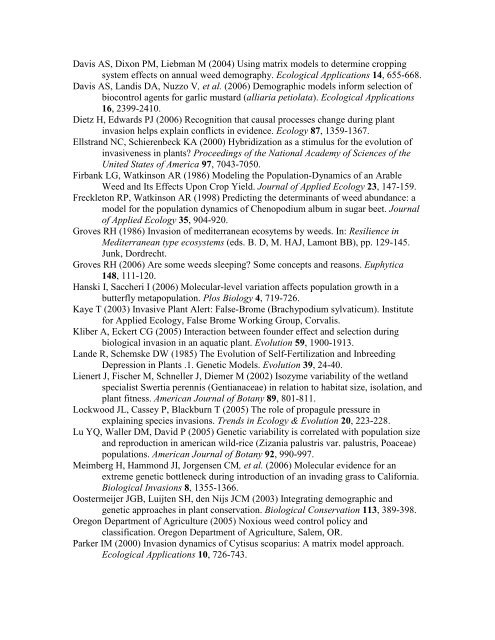Final Report - Center for Invasive Plant Management
Final Report - Center for Invasive Plant Management
Final Report - Center for Invasive Plant Management
- No tags were found...
You also want an ePaper? Increase the reach of your titles
YUMPU automatically turns print PDFs into web optimized ePapers that Google loves.
Davis AS, Dixon PM, Liebman M (2004) Using matrix models to determine croppingsystem effects on annual weed demography. Ecological Applications 14, 655-668.Davis AS, Landis DA, Nuzzo V, et al. (2006) Demographic models in<strong>for</strong>m selection ofbiocontrol agents <strong>for</strong> garlic mustard (alliaria petiolata). Ecological Applications16, 2399-2410.Dietz H, Edwards PJ (2006) Recognition that causal processes change during plantinvasion helps explain conflicts in evidence. Ecology 87, 1359-1367.Ellstrand NC, Schierenbeck KA (2000) Hybridization as a stimulus <strong>for</strong> the evolution ofinvasiveness in plants? Proceedings of the National Academy of Sciences of theUnited States of America 97, 7043-7050.Firbank LG, Watkinson AR (1986) Modeling the Population-Dynamics of an ArableWeed and Its Effects Upon Crop Yield. Journal of Applied Ecology 23, 147-159.Freckleton RP, Watkinson AR (1998) Predicting the determinants of weed abundance: amodel <strong>for</strong> the population dynamics of Chenopodium album in sugar beet. Journalof Applied Ecology 35, 904-920.Groves RH (1986) Invasion of mediterranean ecosytems by weeds. In: Resilience inMediterranean type ecosystems (eds. B. D, M. HAJ, Lamont BB), pp. 129-145.Junk, Dordrecht.Groves RH (2006) Are some weeds sleeping? Some concepts and reasons. Euphytica148, 111-120.Hanski I, Saccheri I (2006) Molecular-level variation affects population growth in abutterfly metapopulation. Plos Biology 4, 719-726.Kaye T (2003) <strong>Invasive</strong> <strong>Plant</strong> Alert: False-Brome (Brachypodium sylvaticum). Institute<strong>for</strong> Applied Ecology, False Brome Working Group, Corvalis.Kliber A, Eckert CG (2005) Interaction between founder effect and selection duringbiological invasion in an aquatic plant. Evolution 59, 1900-1913.Lande R, Schemske DW (1985) The Evolution of Self-Fertilization and InbreedingDepression in <strong>Plant</strong>s .1. Genetic Models. Evolution 39, 24-40.Lienert J, Fischer M, Schneller J, Diemer M (2002) Isozyme variability of the wetlandspecialist Swertia perennis (Gentianaceae) in relation to habitat size, isolation, andplant fitness. American Journal of Botany 89, 801-811.Lockwood JL, Cassey P, Blackburn T (2005) The role of propagule pressure inexplaining species invasions. Trends in Ecology & Evolution 20, 223-228.Lu YQ, Waller DM, David P (2005) Genetic variability is correlated with population sizeand reproduction in american wild-rice (Zizania palustris var. palustris, Poaceae)populations. American Journal of Botany 92, 990-997.Meimberg H, Hammond JI, Jorgensen CM, et al. (2006) Molecular evidence <strong>for</strong> anextreme genetic bottleneck during introduction of an invading grass to Cali<strong>for</strong>nia.Biological Invasions 8, 1355-1366.Oostermeijer JGB, Luijten SH, den Nijs JCM (2003) Integrating demographic andgenetic approaches in plant conservation. Biological Conservation 113, 389-398.Oregon Department of Agriculture (2005) Noxious weed control policy andclassification. Oregon Department of Agriculture, Salem, OR.Parker IM (2000) Invasion dynamics of Cytisus scoparius: A matrix model approach.Ecological Applications 10, 726-743.
















